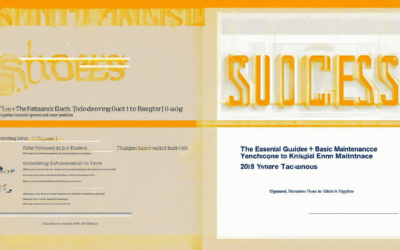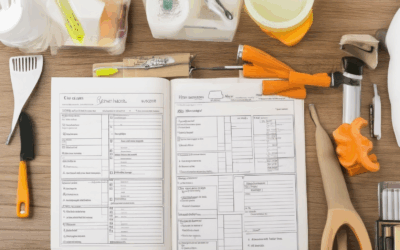Homeownership comes with its fair share of challenges, but mastering basic home repair projects can empower you to tackle issues head-on and save significantly on costly professional services. Whether you’re a seasoned homeowner or new to the game, developing DIY skills for simple home repairs can transform your living space while keeping your budget intact. From fixing leaky pipes to updating outdated fixtures, there’s a world of affordable upgrades waiting for you to explore. This guide offers practical tips, tools, and strategies to help you excel in budget-friendly basic home repair projects, ensuring your home remains in top shape year after year.
Key Takeaways
– Save Money and Enhance Efficiency: Implement DIY tips for basic home repair projects focused on energy efficiency, smart home technology, and eco-friendly renovations to reduce costs and improve sustainability.
– Boost Property Value with High ROI Projects: Invest in kitchen and bathroom remodels, energy-efficient windows, and smart home integrations to maximize your home’s value and return on investment.
– Create Functional and Stylish Spaces: Update your home with modern designs, including smart storage solutions, outdoor living areas, and personalized interior touches for a fresh, inviting look.
– Leverage Expertise in Construction: Explore opportunities in large-scale commercial, high-rise development, and specialty contracting to tap into profitable industries with high demand for skilled labor.

Most Common Home Repairs
Home repairs are a common part of homeownership, and knowing the most frequent issues can help you prepare and address them promptly. Here are some of the most common home repairs and how to handle them effectively:
- Plumbing Issues : Leaky pipes, clogged drains, and malfunctioning water heaters are among the most common problems. Regular inspections can prevent costly repairs.
- Electrical Problems : Faulty circuit breakers, dead outlets, and flickering lights are common electrical issues. Hiring a licensed electrician is recommended for safety.
- Heating, Ventilation, and Air Conditioning (HVAC) : Heating and cooling systems often require maintenance to ensure efficiency. Annual tune-ups can extend the life of your system.
- Appliance Repairs : Refrigerators, dishwashers, and stoves often encounter issues like broken parts or faulty wiring. Refer to the manufacturer’s manual for troubleshooting steps.
By addressing these common repairs promptly and maintaining regular preventive care, you can save money and keep your home in great shape. For professional assistance, contact Sams Maintenance for reliable solutions tailored to your needs.
How to Learn Basic Home Repair
Here’s a step-by-step guide to mastering basic home repair skills:
- Start with the Right Tools : Gather essential tools like a screwdriver set, wrenches, measuring tape, and a toolkit tailored for small projects. These tools are your foundation for most repairs.
- Utilize Online Resources : Visit trusted websites like Sams Maintenance for detailed guides and video tutorials. Platforms like DIY Hacks offer creative solutions for common issues.
- Join Communities : Engage with forums or groups on platforms like Fix It Club . Ask questions, share experiences, and learn from others who have tackled similar projects.
- Practice on Small Projects : Begin with simple tasks like fixing a leaky faucet or patching a wall. Use resources from Tool Kingdom to walk through each process.
- Follow Step-by-Step Guides : Refer to comprehensive guides on sites like WikiHow for clear, visual instructions. Break down complex tasks into manageable steps.
- Stay Safe : Always prioritize safety. Use circuit breakers correctly and wear protective gear when handling electrical or heavy machinery.
- Learn from Experts : Watch instructional videos on channels like YouTube or enroll in local workshops offered by Sams Maintenance for hands-on training.
By following these steps, you’ll gain confidence and proficiency in tackling various home repair tasks.

What Home Improvement Should I Do First?
When deciding the order of home improvements, it’s essential to consider both immediate needs and long-term goals. Here’s a structured approach to guide your decision-making process:
- Assess Structural Integrity:** Begin by inspecting the foundation and walls for cracks or damage. Address any issues promptly to prevent further deterioration and ensure the house remains stable.
- Check for Safety Hazards:** Examine electrical systems, plumbing, and HVAC units for potential issues. Replace outdated wiring, fix leaky pipes, and update the heating system to ensure safety and efficiency.
- Boost Energy Efficiency:** Consider upgrading to energy-efficient windows and doors, and install a modern HVAC system. These improvements can reduce utility bills and increase comfort.
- Improve Curb Appeal:** Start with a fresh coat of paint for the exterior and repair or replace damaged shingles on the roof. Enhance landscaping to create an inviting outdoor space.
- Focus on Functionality:** Prioritize kitchen and bathroom updates to improve daily living. Replace outdated appliances, update cabinetry, and refresh tile or grout for a modern look.
- Address Immediate Needs:** Tackle smaller, quick projects like fixing leaky faucets or replacing worn-out flooring to ensure the home remains functional and comfortable.
By following this plan, you can ensure your home is safe, efficient, and aesthetically pleasing before moving on to more extensive remodels. Tailor the sequence based on your specific circumstances and priorities to maximize both functionality and beauty.

Most In-Demand Home Improvements
Homeowners are constantly seeking ways to enhance their living spaces, improve functionality, and increase property value. Here are some of the most sought-after home improvement projects and trends:
- Energy Efficiency Upgrades : With rising energy costs, homeowners are prioritizing upgrades that reduce consumption. This includes installing energy-efficient windows, upgrading HVAC systems to high-efficiency models, and adding solar panels.
- Smart Home Technology Integration : The demand for smart home devices has surged. Homeowners want seamless control of lighting, security systems, and entertainment through voice commands or mobile apps.
- Eco-Friendly Renovations : Sustainable living is becoming mainstream. Projects like green roofs, rainwater harvesting systems, and permeable paving stones are gaining popularity.
- Kitchen and Bathroom Remodels : These are among the most common and highest-value home improvements. Modern, functional designs with high-quality materials are in demand.
- Outdoor Living Spaces : Homeowners are investing in outdoor kitchens, patios, decks, and pergolas to extend living areas into the backyard.
- Smart Storage Solutions : With limited space indoors, many are turning to custom storage solutions, including Murphy beds, modular cabinets, and vertical storage units.
- Landscaping and Outdoor Lighting : Well-designed outdoor spaces often require professional landscaping services and modern lighting fixtures to create inviting environments.
- Home Automation Systems : Integrating automation into daily routines simplifies life and enhances convenience. Smart thermostats, automated blinds, and robotic vacuums are top choices.
- Interior Design Updates : Personalized spaces are trendy. Custom wallpaper, statement lighting, and unique furniture pieces are transforming traditional interiors into stylish sanctuaries.
These improvements not only reflect current trends but also offer long-term benefits for homeowners. Whether it’s modernizing existing spaces or adding cutting-edge features, the focus is on creating comfortable, efficient, and visually appealing living environments.
Top Home Improvements with Highest ROI
When it comes to boosting your home’s value and enjoying a better return on investment, certain home improvements stand out more than others. Here are five projects known for delivering significant returns:
- Kitchen Remodel : Often cited as one of the most valuable renovations, a kitchen remodel can increase your home’s value by up to 80% of its cost. Upgrading cabinets, countertops, and appliances can modernize your space and appeal to potential buyers.
- Bathroom Remodel : Similar to the kitchen, a bathroom renovation can yield high returns. A well-designed bath or shower space can add substantial value, particularly if you install luxury fixtures or add storage solutions.
- Window Replacement : Energy-efficient windows not only enhance your home’s appearance but also lower utility bills. They can recoup their cost in reduced energy expenses, making them a wise investment.
- Smart Home Technology Integration : Adding smart home features like automated lighting, thermostats, and security systems can elevate convenience and appeal. These technologies often pay for themselves in increased property value and energy savings.
- Deck or Patio Addition : An outdoor living space can significantly boost your home’s curb appeal and functionality. A well-built deck or patio addition can add up to 90% of its cost to your home’s value.
These projects not only enhance your living spaces but also provide tangible financial benefits. Consider consulting with professionals to plan and execute these improvements effectively, maximizing both beauty and value in your home.

Most Profitable Construction Businesses
The construction industry is vast, encompassing a wide range of sectors and specializations. Among these, certain types of construction businesses tend to be more profitable due to factors like scale, demand, and operational efficiency. Below is an analysis of some of the most profitable construction businesses and what sets them apart.
- Large Scale Commercial Construction: Companies specializing in commercial construction, such as office buildings, hospitals, and shopping centers, often enjoy high profitability. Firms like Bechtel and AECOM are leaders in this sector, thanks to their ability to manage massive projects and deliver on time and within budget.
- Residential High-Rise Development: Developers focusing on luxury high-rise apartments and condominiums in urban areas can achieve significant profits. Examples include firms involved in skyscraper construction in cities like New York, Dubai, and Tokyo.
- Specialty Contractors: Companies that specialize in niche areas such as bridge construction, tunneling, and industrial plants often command premium prices due to their expertise and limited competition.
- Green Building Construction: With increasing demand for sustainable architecture, firms specializing in LEED-certified buildings and eco-friendly construction practices can be highly profitable. Companies like Skanska and Interface have strong reputations in this space.
- Infrastructure Projects: Governments and private entities investing in infrastructure, such as highways, dams, and public transportation systems, often partner with profitable construction firms. Examples include firms working on major highway expansions or railway projects.
- Renewable Energy Construction: The growing demand for renewable energy sources has created opportunities for construction companies specializing in solar farms, wind turbines, and energy storage facilities. Companies like SunPower and NextEra Energy are leading players in this sector.
These businesses excel due to their ability to leverage technological advancements, access to capital, and a strong backlog of projects. Additionally, many operate globally, expanding their reach and profitability.
Conclusion
The most profitable construction businesses are those that capitalize on high-demand sectors, adopt innovative technologies, and maintain a strong track record of delivery. Companies like Bechtel, AECOM, Skanska, and renewable energy firms are among the top performers in this industry, driving growth and innovation in construction.




0 Comments